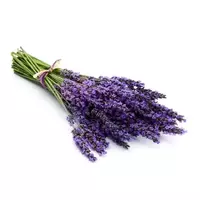Lavender

Lavender, a plant of amazing beauty and certainly useful for the human body. There are more than 30 subspecies of lavender, which differ from each other in distribution range and appearance. In addition, not every type of lavender can be attributed to edible and healing plants.
Lavender is real (Lavandula angustifolia), spiky or narrow-leaved is one of the most ancient and well-known species from the genus Lavender. It is lavender real that is widely used in cooking, as well as medicine. The Mediterranean region is considered the birthplace of lavender, from where the plant spread throughout European territory, as well as in the Caucasus, Africa and North America.
Lavender composition
Lavender refers to evergreen plants, with long but non-wide leaves and flowers of distinctive purple color. In the science of flowers or coloristics, there is a special lavender color to indicate the color of the plant. The taste, aromatic and beneficial properties of lavender are primarily due to the chemical composition of the plant. Lavender contains a colossal amount of essential oils that are extracted from the plant and used in aromatherapy, medicine and cosmetology.
In addition, acetic, valerian, oily and capronic acids were found in lavender. Lavender flowers are used dried or fresh for the manufacture of potions and infusions, which have a number of healing qualities. The beneficial properties of lavender have been proven to be the ability to improve blood circulation. In addition, the benefits of lavender are expressed in the antiseptic and antibacterial properties of the plant. For medical purposes, the ancient Greeks and Romans began to use lavender.
Lavender benefits
Lavender essential oil enjoyed incredible popularity and was not unreasonably classified as a drug. Dried flowers and lavender oil are used in cooking. Lavender, as spice is often used in national French, Italian and Spanish cuisines. Dishes seasoned with lavender instantly acquire a characteristic aroma.
Lavender is used as a natural flavor in the manufacture of some expensive meat and sausage products. There are recipes for original green sauces, as well as vegetable dishes and oil, which are made from thyme, sage, dill and lavender. The main benefit of lavender is that with regular consumption of the plant, immunity is strengthened and the human body becomes less vulnerable to various viruses and colds.
The aroma of lavender can favorably affect the human nervous system. Therefore, lavender oil is used in aromatherapy and massage. For laryngitis and pneumonia, inhalations are made with lavender oil. However, drugs containing lavender have their own contraindications. Do not use drugs with lavender at the same time as iodo or iron-containing drugs. Doctors recommend giving up lavender during pregnancy and with individual intolerance to the plant.
lavender 23 kCal
Energy value of lavender (Ratio of proteins, fats, carbohydrates - ju):
Squirrels: 3.99 g (~ 16 kCal)
Fats: 0.69 g (~ 6 kCal)
Carbohydrates: 0.2 g (~ 1 kCal)
Energy ratio (bj | y): 69% | 27% | 3%
 Español
Español Français
Français Português
Português Русский
Русский 简体中文
简体中文 繁體中文
繁體中文 日本語
日本語 한국어
한국어 العربية
العربية Türkçe
Türkçe Қазақ
Қазақ Deutsch
Deutsch Italiano
Italiano Українська
Українська
